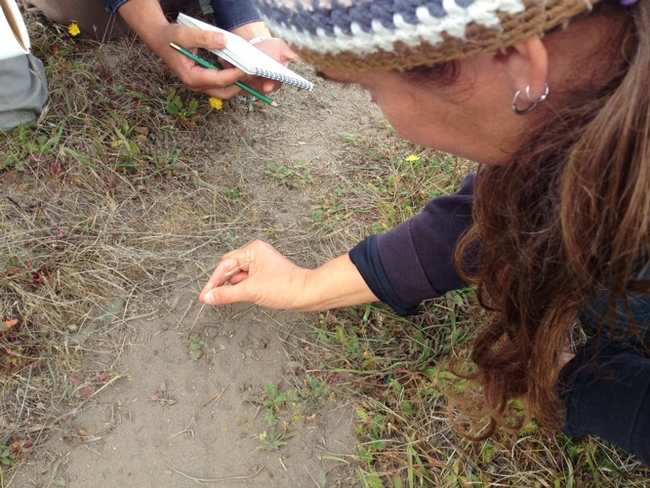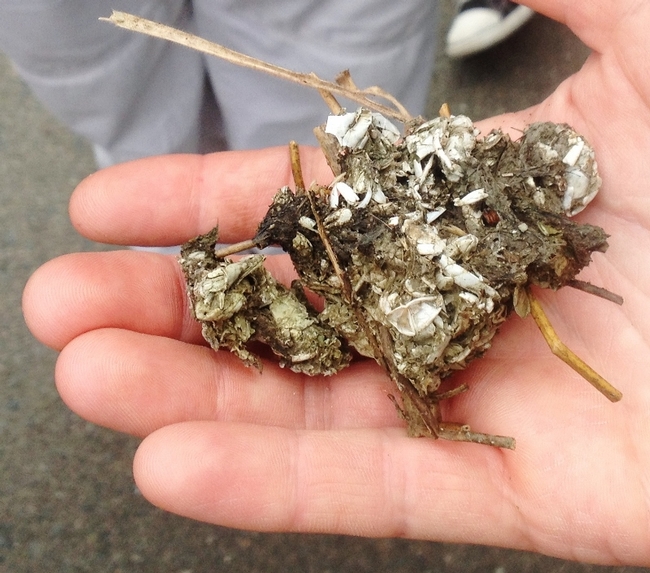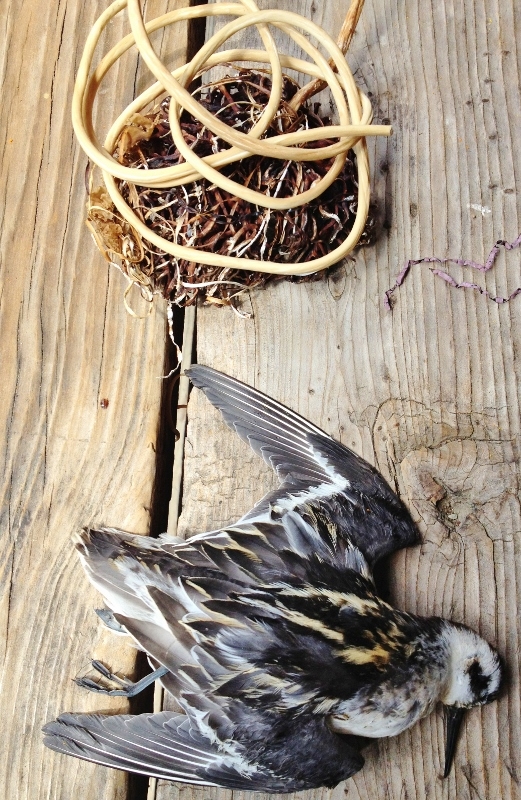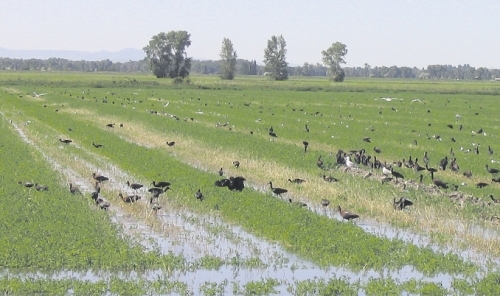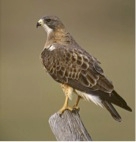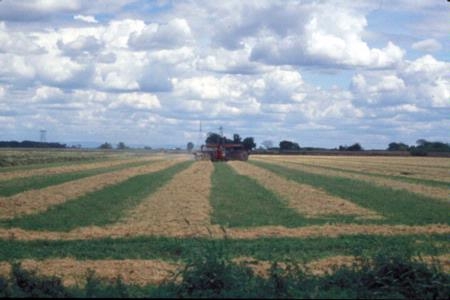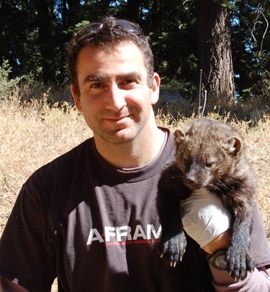Posts Tagged: wildlife
Longer human life spans linked to endangered species loss
It's no big surprise that humans are impacting the planet. But a new study pinpoints a sobering connection.
As human life expectancy increases, so does the percentage of invasive and endangered birds and mammals, according to a study by the University of California, Davis.
The study, published in the September issue of Ecology and Society, examined a combination of 15 social and ecological variables — from tourism and per capita gross domestic product to water stress and political stability. Then researchers analyzed their correlations with invasive and endangered birds and mammals, which are two indicators of what conservationist Aldo Leopold termed “land sickness,” the study said.
Human life expectancy, which is rarely included among indexes that examine human impacts on the environment, surfaced as the key predictor of global invasions and extinctions.
“It’s not a random pattern,” said lead author Aaron Lotz, a postdoctoral scholar in the UC Davis Department of Wildlife, Fish and Conservation Biology when the study was conducted. “Out of all this data, that one factor — human life expectancy — was the determining factor for endangered and invasive birds and mammals.”
The study analyzed data from 100 countries, which included roughly 87 percent of the world’s population, 43 percent of global GDP per capita, and covered 74 percent of the Earth’s total land area. Additional factors considered were agricultural intensity, rainfall, pesticide regulation, energy efficiency, wilderness protection, latitude, export-import ratio, undernourishment, adult literacy, female participation in government and total population.
The findings include:
- New Zealand, the United States and the Philippines had among the highest percentages of endangered and invasive birds.
- New Zealand had the highest percentage of all endangered and invasive species combined, largely due to its lack of native terrestrial mammals. The study said that in the past 700 to 800 years since the country was colonized, it has experienced massive invasion by nonindigenous species, resulting in catastrophic biodiversity loss.
- African countries had the lowest percentage of invasive and endangered birds and mammals. These countries have had very little international trade, which limits opportunities for biological invasion.
- As GDP per capita — a standard measure of affluence — increased in a country, so did the percentage of invasive birds and mammals.
- As total biodiversity and total land area increased in a country, so did the percentage of endangered birds. (Biodiversity in this context is not a measure of health but refers to the number of species in an area.)
Lotz said the study’s results indicate the need for a better scientific understanding of the complex interactions among humans and their environment.
“Some studies have this view that there’s wildlife and then there’s us,” said Lotz. “But we’re part of the ecosystem. We need to start relating humans to the environment in our research and not leave them out of the equation. We need to realize we have a direct link to nature.”
The study was featured in the Los Angeles Times, Wired, and the U.K.'s Daily Mail among other media.
Time spent learning about nature in the outdoor classroom is irreplaceable
On a recent misty coastal morning, a group of 25 adults formed a circle on the beach in front of the UC Davis Bodega Bay Marine Lab. We sat cross-legged with our field journals in our laps, toes digging into the cold damp sand and jackets zipped up tight to keep out the salty breeze.
Our circle was comprised of young and old, men and women, educators and students, budding and seasoned naturalists alike. We were all paying close attention to our UC California Naturalist instructor from Occidental Arts & Ecology Center who was unraveling the mysteries of animal tracks and sketching them for our benefit in a large field journal. She was setting the stage for our morning activity: to explore the sand dunes for animal sign. As we took copious notes, she described the wide diversity of animals that might use the rocky intertidal areas, sandy beaches, lagoon mudflats, tidal saltmarshes, sand dunes, coastal bluffs, coastal scrub, and freshwater wetland communities that occur in the near vicinity. She demonstrated how we could discern which was a front or hind foot track, left or right side, why and how one might determine what the animal was doing in that location, and more. She left some questions unanswered, encouraging us to explore, observe, draw, and discuss what we found. She told us to share our observations and piece together the stories, so off we eagerly hiked to explore animal sign.
In less than an hour we found raccoon, deer, and myriad bird tracks, nibbled vegetation, an endangered red-legged frog, a recently deceased shorebird called a phalarope, and a large handful of shell-filled river otter scat. We saw seabirds, waterbirds, passerines, and raptors fly by. The entire class was elated when we re-convened in the parking lot to share our observations.
As I chatted with California Naturalist Program Director Adina Merenlender, UC Cooperative Extension specialist in the Department of Environmental Science, Policy and Management at UC Berkeley, on the windy road back to Occidental, we came to the conclusion that not only had we immensely enjoyed a morning outside, recorded some amazing discoveries, and accomplished a site visit with a new partnering institution, we felt like we needed the time out in the nature.
We discussed the term “nature deficit disorder” coined by Richard Louv, author of Last Child in the Woods, which points to a modern issue of the broken bond between children and nature as a cause of the rise in childhood obesity, attention disorders and depression. Louv asserts that a “growing body of research links our mental, physical, and spiritual health directly to our association with nature — in positive ways . . . we can now assume that just as children need good nutrition and adequate sleep, they may very well need contact with nature.”
Dr. Merenlender and I reaffirmed that time spent in nature as adults can also serve the dual purposes of educating and soothing maladies. Indeed, on this outing exploring the dunes we managed to learn about the local area while invigorating ourselves and alleviating the recent stress of rigorous professional and personal schedules!
Data from the first two years of UC California Naturalist Program evaluations support our theory that time in nature is productive and energizing for students.
California Naturalist Program staff and Directors firmly believe that formal classroom time paired with valuable time spent learning in nature allows this successful program to flourish and fosters a diverse community of naturalists that promote stewardship of California's natural resources.
Alfalfa benefits wildlife and the environment, in addition to its economic value
Alfalfa farmers are on their second hay cutting in California’s Central Valley. Lush green fields are swathed with new generation rotary disk mowers that are nearly twice as fast as the conventional sickle mowers, cutting about 150 acres of alfalfa a day. Alfalfa hay fields are cut from four to ten times a season, averaging about seven tons per acre per year. It’s a profitable crop these days, with prices for high quality hay frequently reaching $250/ton.
But in addition to its over $1 billion value to the state of California, alfalfa provides a host of environmental benefits that are frequently overlooked. What are these benefits?
Benefits to the soil. In addition to being an important cash crop for growers, alfalfa is good for our soil. Alfalfa is a perennial flowering plant in the pea family that is planted in the fall and remains in a field for four to six years. The crop requires few inputs, as the plants fix their own nitrogen from Rhizobia bacteria colonizing the roots, with 90 percent coming from atmospheric nitrogen. Free fertilizer from nature! The long alfalfa stand life also gives the soil a chance to rest from frequent field crop rotations, helps provide nitrogen for subsequent crops and improves soil tilth.
Alfalfa is an insectary. Alfalfa also hosts a diversity of insects, many of which are beneficial, such as lady beetles and parasitoid wasps. These in turn help control other types of insect and mite pests in alfalfa and other crops, potentially saving growers money for pest control. One option to further manage crop pests is by strip cutting the alfalfa, a process that leaves some uncut areas during harvest so that alfalfa serves as a trap crop, holding pests that could infest neighboring crops.
Wildlife loves alfalfa. With nearly a million acres of alfalfa grown in California, alfalfa also serves as an important feeding and resting area for many species of birds, such as curlews, white-faced ibis, and Swainson’s hawks, all species of conservation concern. With historic wetlands significantly reduced in our state, alfalfa is second only to rice in terms of its value in providing habitat for wildlife, according to wildlife specialists. Growers often rely on birds foraging in alfalfa to help control rodent pests such as the gophers and voles that thrive in alfalfa fields. As you drive by alfalfa stands, look for flocks of birds that follow the irrigation water, picking off rodents, insects, and earthworms that are pushed out of the soil when fields are flooded.
Many of these wildlife benefits have been documented by bird-lovers (For more information, see Farming for birds: Alfalfa and forages as valuable wildlife habitat).
Alfalfa-ice cream in the making! Markets for alfalfa primarily include the dairy industry, with alfalfa being an important part of a cow’s feed ration, as it provides high protein and energy for high milk production. This is economically important (the dairy industry is worth $7 billion per year) but also important for human nutrition. A California alfalfa field can produce 2,400 gallons of milk per acre. So the next time you have pizza (with cheese), milk on your cereal, or ice cream, thank alfalfa.
Other markets for alfalfa include livestock, such as horses, sheep, goats and beef cows. Most of our hay stays in state, but other significant markets include China, Japan and Saudi Arabia. Alfalfa seed is also an important source of honey and feeding areas for bees.
When you smell the fragrance of newly mown hay, thank the alfalfa grower and the “Queen of Forages” which helps produce milk right here in California. Watch the fields for bird activity and see if you can spot some Swainson’s hawks feeding on rodents and helping alfalfa growers with pest control, or curlews and egrets foraging for prey. But also be grateful for a host of important wildlife and environmental benefits to the landscape that alfalfa provides.
For more information, see the UC alfalfa workgroup website.
California Naturalist Program grows a new constituency for nature
Have you heard of the UC ANR California Naturalist Program? This new UC ANR program fosters a diverse community of naturalists and promotes stewardship of California's natural resources through education and service. Designed to introduce Californians to the wonders of our unique ecology and engage volunteers in stewardship and study of California’s natural communities, California Naturalist provides hands-on instruction and exposure to real world environmental projects designed to inspire adults to become active citizen scientists and enhance their personal connection with the natural world.
The California Naturalist Program encourages Californians to help protect and preserve our unique and diverse wildlife, habitats, rivers, lakes and coastal resources, wild and urban alike. Currently, the program certifies naturalists through 10 partnering institutions statewide, and continuing education units/college credit are available. Becoming a California Naturalist is a commitment to life-long learning. Advanced training opportunities for naturalists are continually offered by California Naturalist partners and the University of California. The program is in the planning stages for a first bi-annual statewide conference in 2014.
California Naturalist’s newest course offerings include two summer 2013 in-residency intensive courses at Nevada County’s UC Berkeley Sagehen Creek Field Station (July 8 - 14, 2013) and Sonoma County’s Occidental Arts & Ecology Center (August 15 - 22, 2013). These residential summer courses provide a chance to immerse yourself in the wonders of California’s unique ecology. Through a combination of science curriculum, guest lecturers, field trips and project based learning, participants will advance their ability to observe and understand nature. Great for teachers, docents, environmental professionals, and everyone interested in natural history.
Please learn more about taking a class or becoming a partnering institution on the website, find us on Facebook or contact us directly at canaturalist@ucanr.edu or (707) 744-1424 Ext. 104.
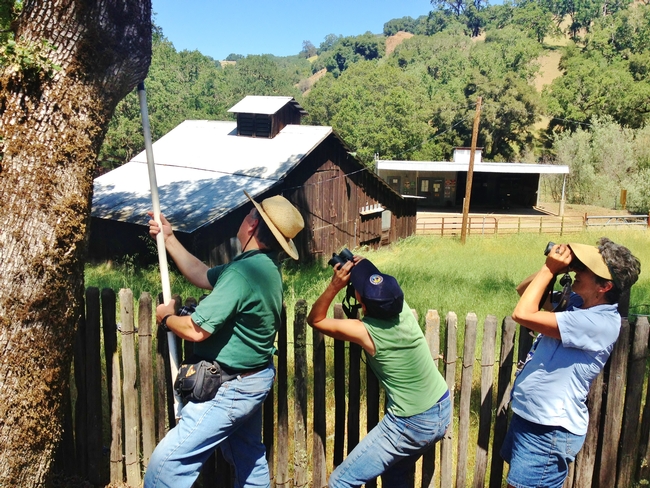
California Naturalists in-training participate in NestWatch, a nationwide monitoring program designed to track status and trends in the reproductive biology of birds.
Perils of illegal marijuana crops
Rodenticides used on illegal marijuana farms have already been shown to pose serious harm to the fisher—a cat-sized carnivore found in forests across Canada and four regions in the U.S. (Previous news article.)
Mourad Gabriel, a doctoral candidate with the Veterinary Genetics Laboratory at UC Davis School of Veterinary Medicine, provides a more comprehensive look at the situation in the recent issue of The Wildlife Professional, put out by The Wildlife Society. (Article here.)
New information looks at risks to other species and to the ecologists and biologists conducting wildlife research on community and public lands where more of these crops are being cultivated.
Highlights include:
- Newly documented fisher mortalities (necropsies done at UC Davis’ California Animal Health and Food Safety Laboratory System)
- New data documenting just a glimpse of potential environmental degradation possibly occurring on our public lands
- First mention of toxicants like carbamates and organochlorides (DDT etc...) that are being found in California grow sites
- Provides readers with information on how some of these toxicants are placed at grow sites to maliciously poison wildlife
- New info and discussion points of "what are" the potential effects of ...such as damming water courses, putting toxic slurry of chemicals in dammed creeks, cutting riparian zones, human feces (affects salmon and many other species)
- First-hand accounts of ecologists and biologists conducting wildlife research being shot at, chased and threatened
- Quantifies the loss of project area access, and data from fisher projects in California public lands
There is also a link to a video that offers a first account visual representation of what a fisher looks like, the unfortunate visual effects of toxicosis and the realistic outcome to wildlife from these illicit activities on tribal and public lands.
For more information, contact Mourad Gabriel, mwgabriel@ucdavis.edu or Trina Wood, tjwood@ucdavis.edu



